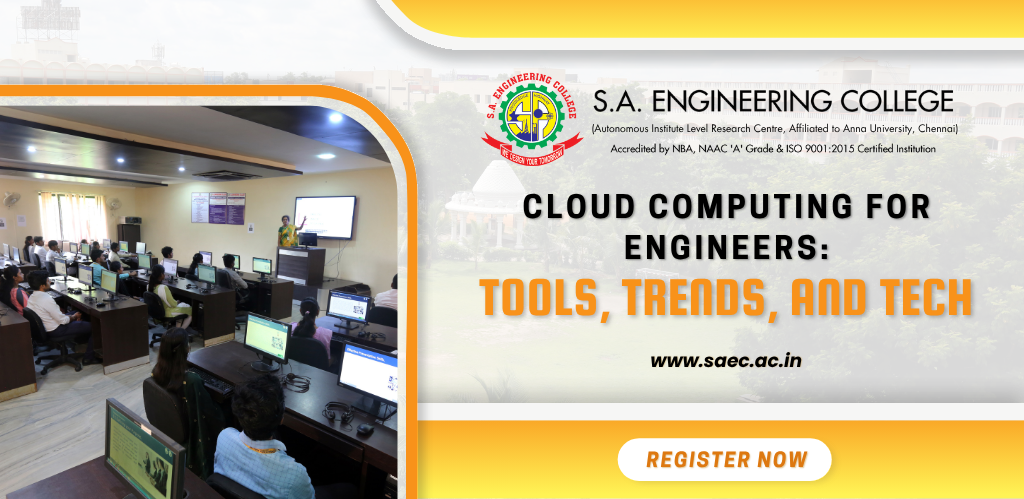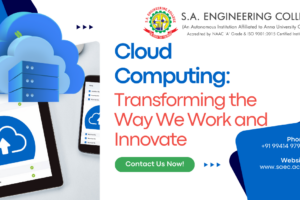
Cloud Computing for Engineers: Tools, Trends, and Tech
- Posted by S.A.E.C
- Categories Cloud Computing
- Date June 1, 2025
In the rapidly evolving landscape of engineering, cloud computing has emerged as a pivotal force driving innovation, efficiency, and scalability. From facilitating complex simulations to enabling real-time collaboration across geographies, cloud technologies are reshaping how engineers design, analyze, and implement solutions. This blog delves into the essential tools, prevailing trends, and cutting-edge technologies in cloud computing that are transforming the engineering domain.
1. The Essence of Cloud Computing in Engineering
Cloud computing refers to the delivery of computing services—including servers, storage, databases, networking, software, analytics, and intelligence—over the Internet (“the cloud”) to offer faster innovation, flexible resources, and economies of scale. For engineers, this translates to:
On-Demand Resources: Access to high-performance computing without the need for significant capital investment. Engineers can deploy computationally intensive applications like fluid dynamics simulations, finite element analysis, and 3D modeling instantly.
Scalability: The ability to scale resources up or down depending on project requirements. Whether it’s an expanding data analysis project or a time-bound product launch, cloud infrastructure offers elastic capacity.
Collaboration: Cloud platforms allow seamless collaboration among multidisciplinary teams across geographies. Engineers can share large files, co-edit documents, and manage tasks in real-time using cloud-enabled platforms.
Cost Efficiency: Pay-as-you-go pricing models help engineering firms avoid overspending. Instead of investing in costly hardware, resources are rented based on actual use.
2. Essential Cloud Computing Tools for Engineers
A myriad of tools cater to the diverse needs of engineers in the cloud ecosystem. Here’s an overview of some pivotal ones:
Infrastructure as a Service (IaaS)
Amazon Web Services (AWS): With over 200 fully featured services, AWS is a go-to choice for scalable computing, storage, and content delivery. Engineers use EC2 for compute capacity and S3 for storing project data securely.
Microsoft Azure: Azure offers virtual machines, app services, and machine learning tools that cater to engineering analysis, prototyping, and production environments.
Google Cloud Platform (GCP): Known for its speed and data analytics, GCP is ideal for managing and analyzing massive engineering datasets using BigQuery and TensorFlow.
Platform as a Service (PaaS)
Heroku: Heroku simplifies deployment for applications written in popular programming languages. Engineers working on app-based interfaces or monitoring dashboards prefer it for its simplicity.
Google App Engine: A fully managed platform that automatically scales applications. Engineers can deploy APIs and models without infrastructure management.
Software as a Service (SaaS)
AutoCAD 360: Enables engineers to view, edit, and share DWG drawings from any device, offering flexibility in project design and review.
MATLAB Online: Allows engineers to perform matrix manipulations, algorithm design, and data visualization directly in the cloud without software installation.
DevOps and Automation Tools
Terraform: Engineers use Terraform to write infrastructure as code (IaC), allowing version-controlled infrastructure that can be automatically deployed and replicated.
Ansible: Automates software provisioning and deployment. Engineering teams benefit from its ability to standardize development, testing, and production environments.
Collaboration and Project Management
Asana: Provides visual project tracking, timelines, and workload management ideal for multi-stage engineering projects.
Jira: Highly customizable for engineering workflows, including bug tracking, feature requests, and task prioritization.
3. Emerging Trends in Cloud Computing for Engineering
The cloud computing landscape is continually evolving. Here are some trends that are particularly relevant to engineers:
Edge Computing
Edge computing processes data at the source (such as sensors or local devices) rather than in a centralized data center. For engineers working on autonomous systems, robotics, and real-time monitoring, this leads to faster data response and reduced bandwidth use.
Hybrid and Multi-Cloud Strategies
Engineers are increasingly adopting hybrid strategies that combine on-premises infrastructure with cloud services. Multi-cloud strategies involve using services from different cloud providers to optimize performance, reduce costs, and avoid vendor lock-in.
AI and Machine Learning Integration
Major cloud platforms provide AI and ML tools for engineers. Applications include predictive maintenance in manufacturing, demand forecasting in civil planning, and optimization algorithms in mechanical design.
Serverless Computing
Serverless architectures, such as AWS Lambda and Azure Functions, allow engineers to write and deploy code without managing infrastructure. It’s ideal for event-driven applications like automated testing or data processing.
Enhanced Security Measures
With data breaches on the rise, cloud providers are investing in AI-powered security, two-factor authentication, and zero-trust models to safeguard engineering data.
4. Cloud Computing Technologies Shaping Engineering
Several technologies within the cloud domain are particularly impactful for engineers:
High-Performance Computing (HPC)
HPC in the cloud offers immense processing power for simulation-heavy tasks like CFD, FEA, and seismic analysis. Engineers can rent processing clusters on demand without maintaining physical servers.
Digital Twins
A digital twin is a virtual replica of a physical asset or system. In cloud environments, engineers use these models for real-time monitoring, diagnostics, and predictive maintenance of assets like turbines, bridges, and electrical grids.
Internet of Things (IoT)
Engineers leverage cloud-integrated IoT for smart manufacturing, predictive analytics, and automated systems. Platforms like Azure IoT Hub and AWS IoT Core manage connected devices and process streaming data.
Blockchain Integration
Blockchain ensures secure and immutable records in supply chains, construction projects, and contract management. Cloud-enabled blockchain platforms like IBM Blockchain and Azure Blockchain Service support engineering applications needing traceability and trust.
5. Challenges and Considerations
While cloud computing offers numerous benefits, engineers must navigate certain challenges:
Data Security and Privacy: Ensuring data confidentiality, especially with intellectual property and client information, remains a top priority.
Compliance: Engineers must ensure that their cloud solutions comply with industry regulations such as ISO, GDPR, and HIPAA.
Latency Issues: Time-sensitive applications, especially in automation or control systems, can suffer from cloud latency.
Cost Management: Misconfigured or unused cloud resources can lead to unexpected costs. Engineers should use budgeting tools and resource monitoring.
Skill Gaps: Engineers must upskill continuously to understand cloud technologies, scripting, and deployment processes.
6. Future Outlook
The future of cloud computing in engineering looks promising:
Quantum Computing: Cloud-based quantum computing from companies like IBM and Google will enable unprecedented simulation and optimization.
5G Integration: With ultra-fast data transmission, 5G will improve real-time cloud access for mobile engineering applications.
Decentralized Cloud Infrastructure: Technologies like InterPlanetary File System (IPFS) will decentralize data storage and increase resilience.
Cloud-Based AR/VR: Used in engineering education, design review, and client presentations.
Engineers who remain agile and continuously adopt new cloud tools will be well-positioned to lead innovation across industries.
Conclusion
Cloud computing stands as a cornerstone in modern engineering, offering tools and technologies that drive innovation, efficiency, and collaboration. By embracing cloud solutions, engineers can overcome traditional limitations, streamline workflows, and pioneer groundbreaking solutions in their respective fields. The cloud isn’t just a storage space—it’s a dynamic ecosystem that empowers engineers to build smarter, faster, and more sustainably.
You may also like

Know About The Cloud Computing: A Comprehensive Guide

